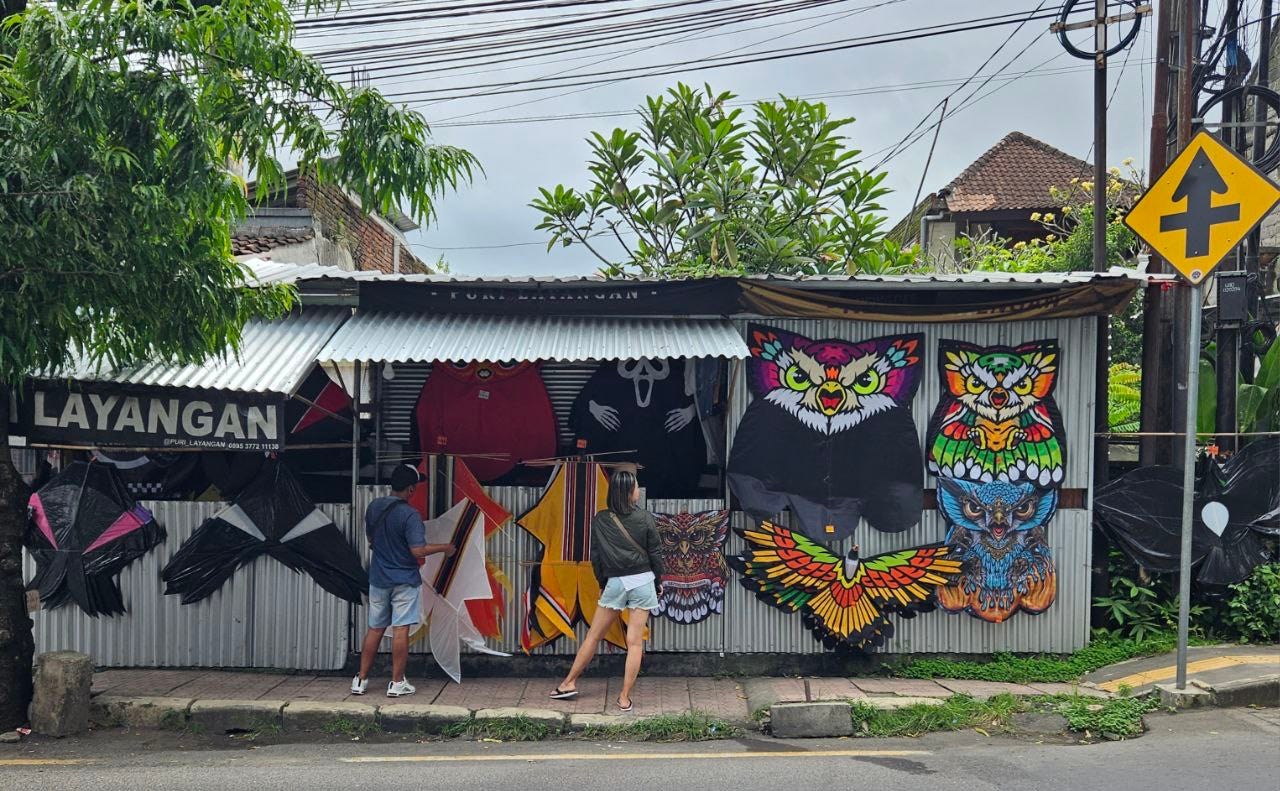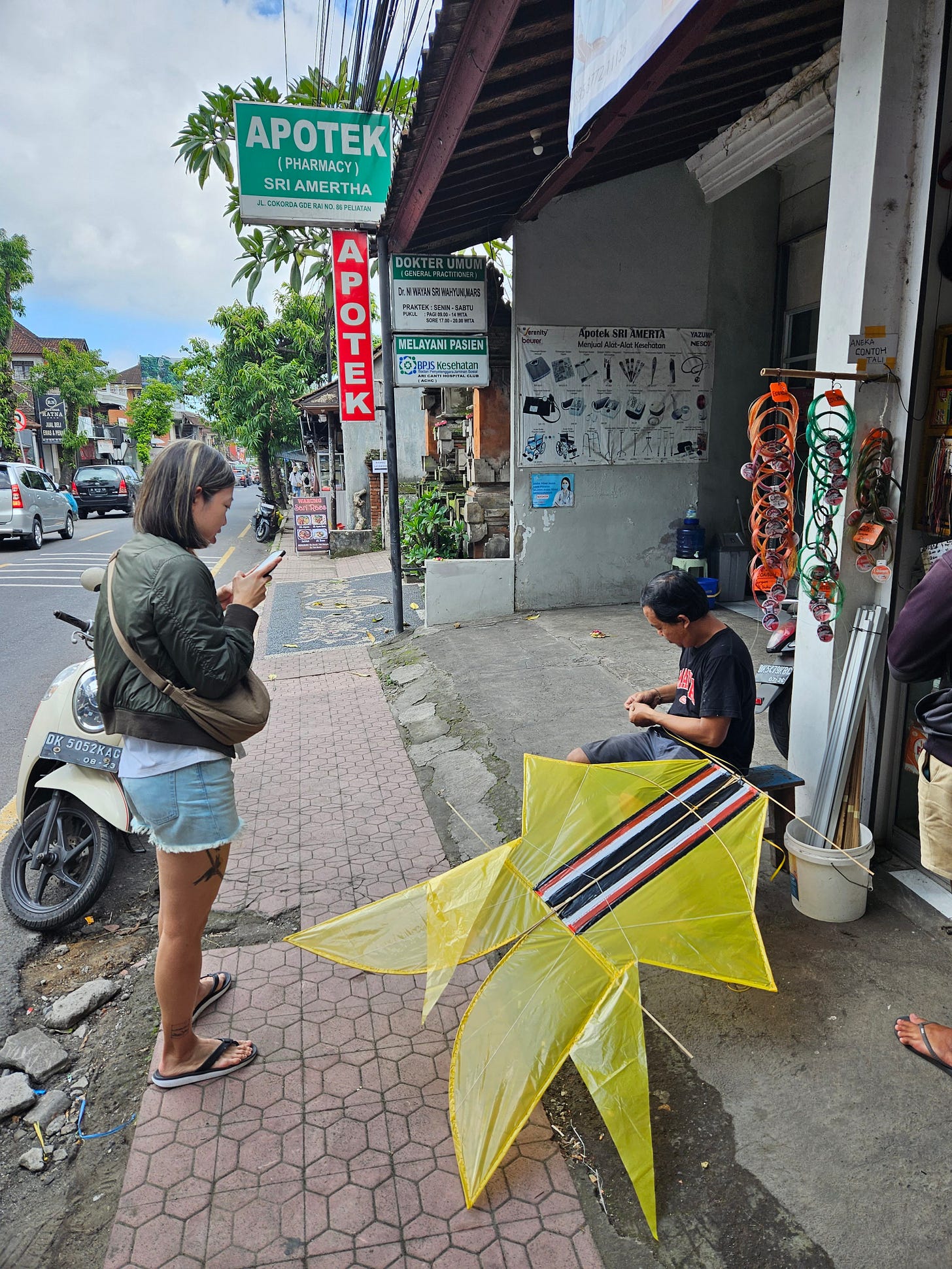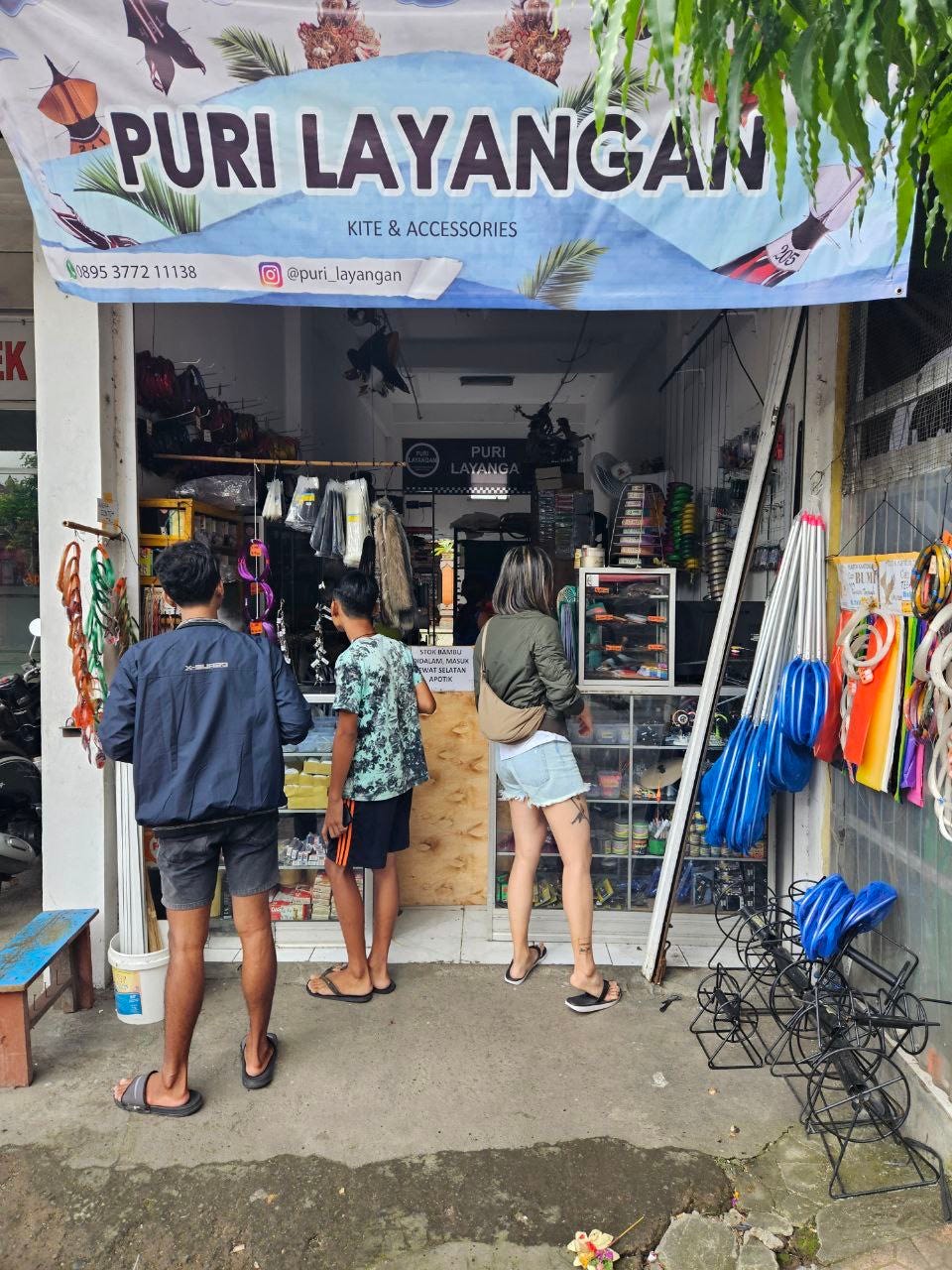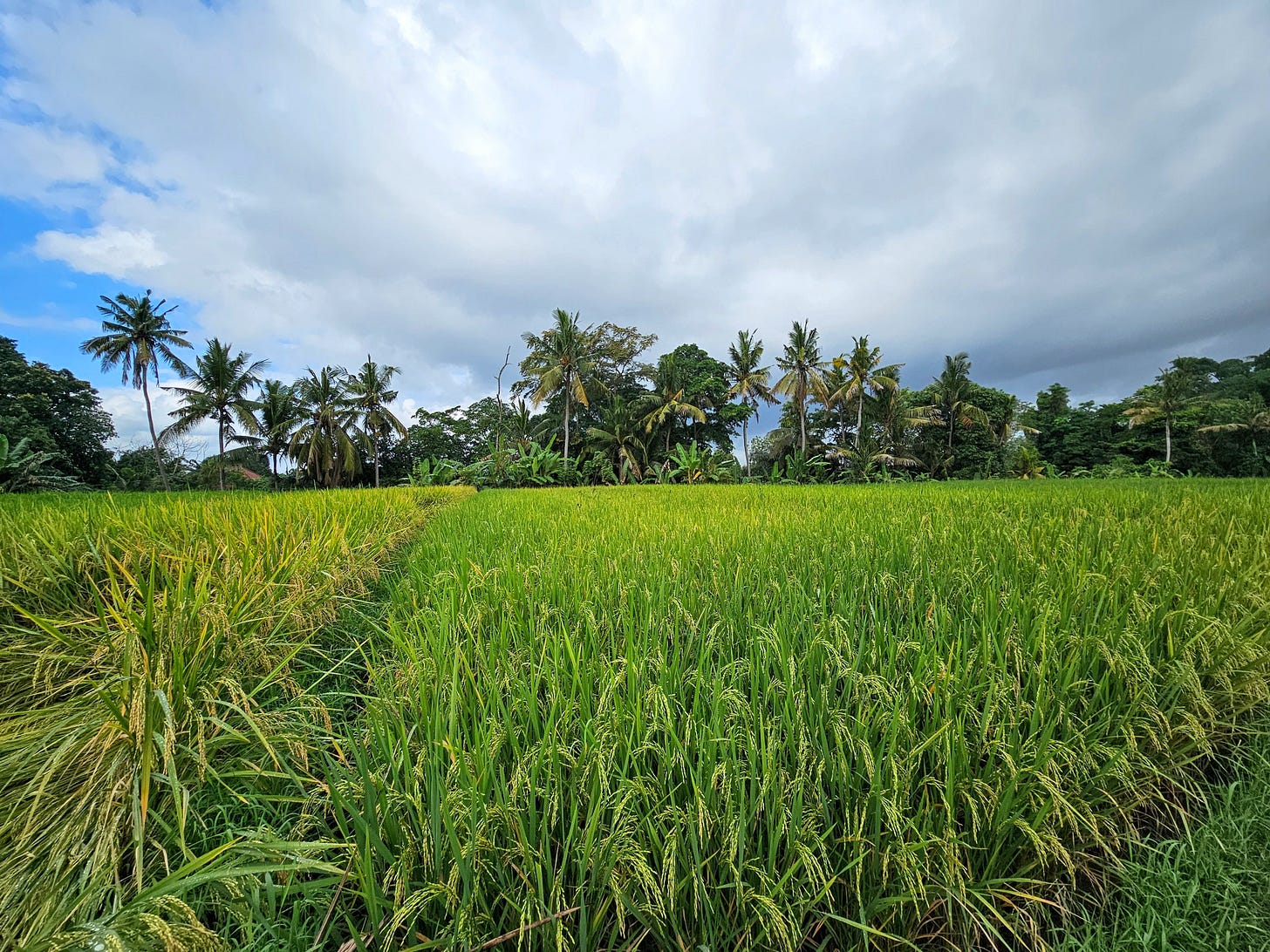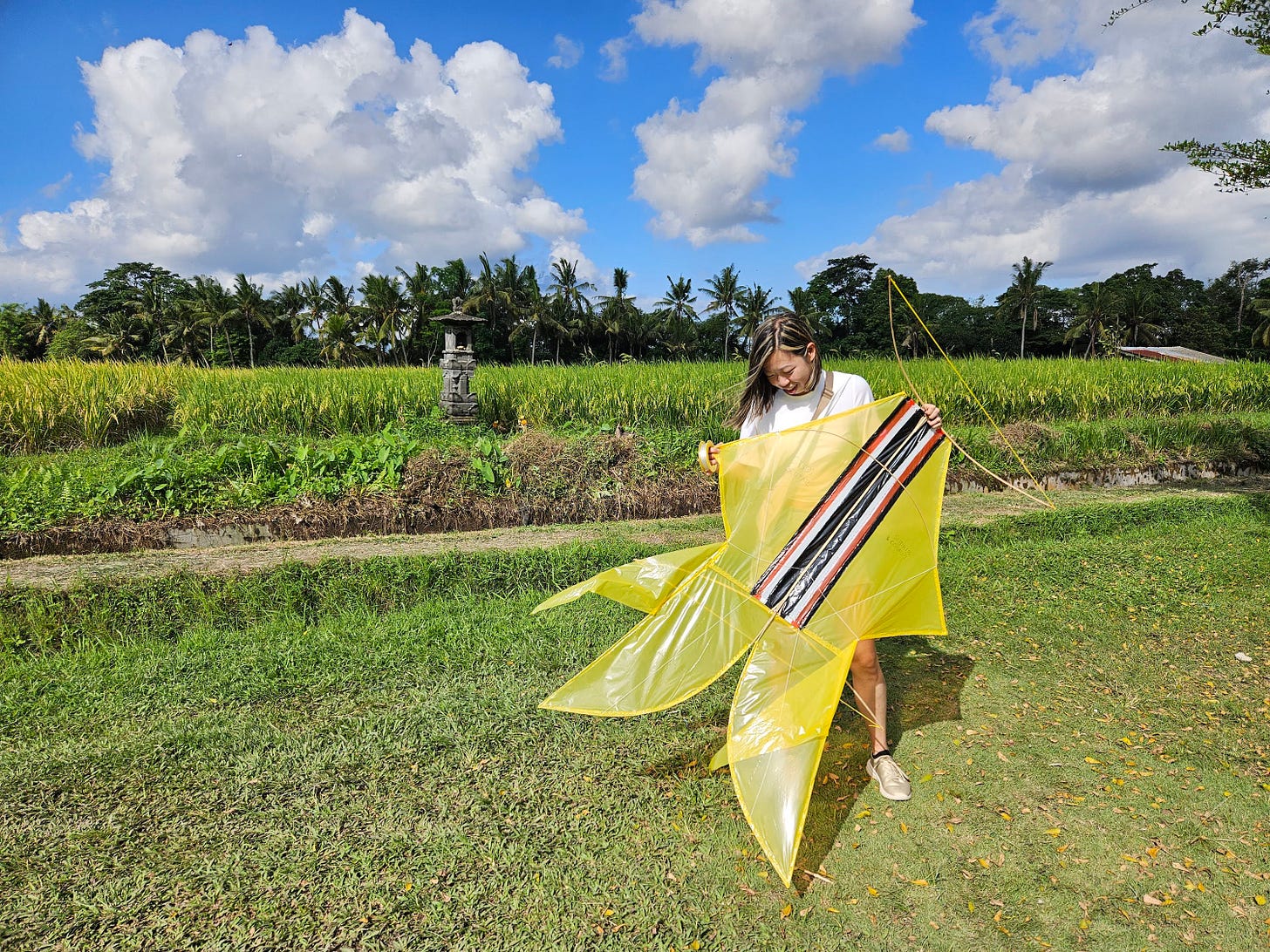We spend two days trawling Ubud for the right kite. Atik, who’s staffing the guesthouse I’m staying at, is now invested in the search. With my classroom-taught Bahasa Indonesia, I struggle to keep linguistic pace with her excitement. She pulls out her phone, pointing to a pharmacy on the map about a kilometre from where we are: I live really close by, and I saw a couple shops selling kites right on the street! She adds, oh, oh, remember to ask them for benang. She pulls an invisible nylon line through her hand, ask them to tie it for you, the kite doesn’t come with it.
It’s kite season in Bali, part of a broader religious practice tied to cycles of rice planting and growing to thank the gods for a bountiful harvest. Every time I look up, the cloud columns—massive and melodramatic—are speckled with tiny kites in the shape of leaves (pecukan), dragons (janggan) and long-tailed fish (bebean). Every day, the kites cluster around the horizon line of the sawah or rice paddy I’m staying in, a ten-minute walk across muddy bunds to a little two-storey house shared with other guests. It’s close enough to the Ubud town centre, but far enough that the only thing I wake to are the sounds of enthusiastic crickets, frogs, and rafts of ducklings chasing down their morning feed. Every morning, the kites are still there, and I wonder how their delicate skeletons and cloth bodies aren’t pulled apart by the wind, and if anyone is piloting them or they’ve been anchored to posts in the ground. Kites are knotted to Balinese spiritual life; they’re believed to have been introduced to Bali by the embodiment of Lord Shiva in the form of rare angon, or a shepherd boy1. Even today, pecinta layang-layang or kite lovers are also known as rare angon, after the young cowherds who keep one eye on their cattle and the other on their kites.
I see the shop immediately. The kites are hung up in two neat rows in the storefront, mostly owls in neon colours glaring out at the street, along with one of the iconic mask from Scream. The most expensive kite, at Rp. 200,000 (S$18) is one of a life-sized eagle, its wings spread wide. I linger on these birds of prey for a moment, but I’m drawn to the collection next to them, the kites in plain block colours: black, yellow, red, white. I’ve never been in a specialty kite store, and it feels very similar to a specialty fishing store: all permutations of reels and lines and lengths for the kite you want, with extensions and modifications you can get on the spot. I point to a yellow kite with a body of sturdy silk cloth. The storekeeper frowns. This is permanent, she tells me. I’m still accumulating new kite vocabulary in Indonesian and I don’t quite understand what she means. You rode a scooter here, yah? She picks up one of the angry owl kites and begins folding it in at its bamboo joints: This one is not permanent. I understand now: she’s worried I won’t be able to ferry such a large, unfoldable kite back on the scooter through the narrow Ubud streets, clogged with post-pandemic tourist traffic. But the large yellow kite calls to me, a bebean or broad-tailed fish kite. Okay, she says, but take the plastic one. The cloth one—lebih keras. Harder to fly.
Her colleague begins preparing the kite, adding on what look like two archer’s bows on either side. I find out later that these are called guwang, sonic modifications made specifically for Balinese kites so that they can be heard across enormous distances2. The kite, once flat against a display wall, shivers to life. The taut string knotted to these bows begins to vibrate with every touch of the wind, sounding a lot like the buzz of a drone. The kitemaker tells me to get on the scooter, and teaches me how to tuck the kite flat under my arm while holding on to its spine. As the scooter revs up, the kite jerks against the inside of my elbow and its vibrations get more fervent, frantic. It squirms next to me, raring to get into the sky.
Why Bali? my Singaporean friends ask, puzzling over my desire to visit one of the most frequented getaways this side of the archipelago—it’s so touristy. They’re not wrong. Tourism is both a builder and destroyer of Bali, of which I am now also a part. The region is thick with a new influx of Australian and Russian nouveau riche and digital nomads; there are signs with parallel translations in Cyrillic all across Seminyak and Canggu. But I often don’t feel a particular desire to seek out “singular” tourist experiences. I like revisiting places, becoming a regular, seeing how its psychogeographies shift over time. Here I find myself away from the spotlight of the “official” Bali Kite Festival happening over the weekend, where thousands of pecinta layang-layang will descend on Sanur beach with their magnificent, sculptural kites. Instead I’m in this tiny kite shop, its owner confused but intrigued by an equally confused and intrigued foreigner who’s somehow managed to find a sawah for her traditional kite.
I’m also in Bali for a small writing retreat I’ve gifted to myself: to complete my Ph.D. dissertation. It’s been a five-year writing journey, and as I’ve trudged to the finish line my internal literary landscape has felt increasingly denuded. I’ve joked with friends that I call academic writing ficus academicus—the strangling fig of writing. All my life—as an arts journalist, an amateur poet, a theatre critic, a dramaturg—I’ve enjoyed exploring different writing registers. I dislike bending my writing to fit genre; I prefer creating a readership through the writing that I do. Writing to fit academia’s conventions sent me into a low-grade, years-long panic as the abundance and wilful unruliness of my writing was slowly pruned away. In April, as I fretted over the final few chapters of my dissertation, sleep deprived and miserable, I did a tarot reading with an artist friend, Zarina. The first card we pulled together from her dozens of decks was of Bhumi Devi, goddess of the earth, harvest and fertility. Zarina gasped, pressing her hands over her mouth, this is a good one, she said. The card’s accompanying text is heavy with mentions of abundance, bounty, blessing. Bless the earth, and you will be blessed in return. As we speed back to the open paddy, the kite straining against my arm begins to feel like a tribute.
The last time I was in Bali was when I was seven; this time, almost thirty years later, I’m paying more attention to its “tourist island” economy. Tourism dependence is sometimes described as a metaphorical form of monocropping: the lack of economic diversity makes the place more vulnerable to crisis3. A driver I spoke to, a former divemaster working on Nusa Penida, resorted to selling pisang goreng with his wife during the pandemic as the lack of tourist revenue devastated Balinese livelihoods. “Diversity is the enemy of epidemics,” the anthropologist James C. Scott wrote when he described how colonial administrators forced local populations across the equatorial belt in Africa and Asia to convert their wild, dense agricultural plots to farm single species4. The colonialists wanted orderly systems of monoculture, not this primitive, “childish” sprawl. But in a profuse, prolific tropical environment with far more species of flora and fauna than any temperate environment might muster, the seemingly disorderly polycropping plays a vital role: it protects thin tropical soils from the erosion of wind and torrential monsoons, where drought-resistant crops can coexist with and complement crops that need the rain. Some writers may enjoy cultivating a particular species of writing, but the planned chaos of polycropping speaks to me.
Atik claps when she sees the kite. She points to a grassy “runway” down the centre of the sawah where I can take off, sending the kite up behind me. I begin my sprint and I feel the nylon, hot through my palm, unspooling towards the sky. The kite’s vibrations are feverish now, so loud I can still hear it shrieking with delight even though it has risen several storeys off the ground. You’re running too far! Atik yells, but I can’t hear her. The kite narrowly misses a squat pair of trees, then rises up a thermal and into the clouds. I feel like a child again, running down the open field at Marina Bay, pre-casinos, pre-barrage. Bless this field, I think as I jog down the path. Bless my writing, bless its polycultural mess, bless its cycles of growth and harvest. Bless the ending of an old chapter and the beginning of a new one. I turn to look up, and the fish is a small yellow sun swimming through the sky. Bless all of us, regardless and because.
I finished writing my Ph.D. dissertation in Bali last week.
“A history of the King in the sky: Balinese Kite Festival” (2017) by Putu Bagus Anggaraditya, in the Bali Tourism Journal 1 (1), pp. 3-6
ibid.
Island Tourism: Sustainable Perspectives (2011), edited by Jack Carlsen and Richard Butler
Seeing Like A State: How Certain Schemes to Improve the Human Condition Have Failed (1998) by James C. Scott



